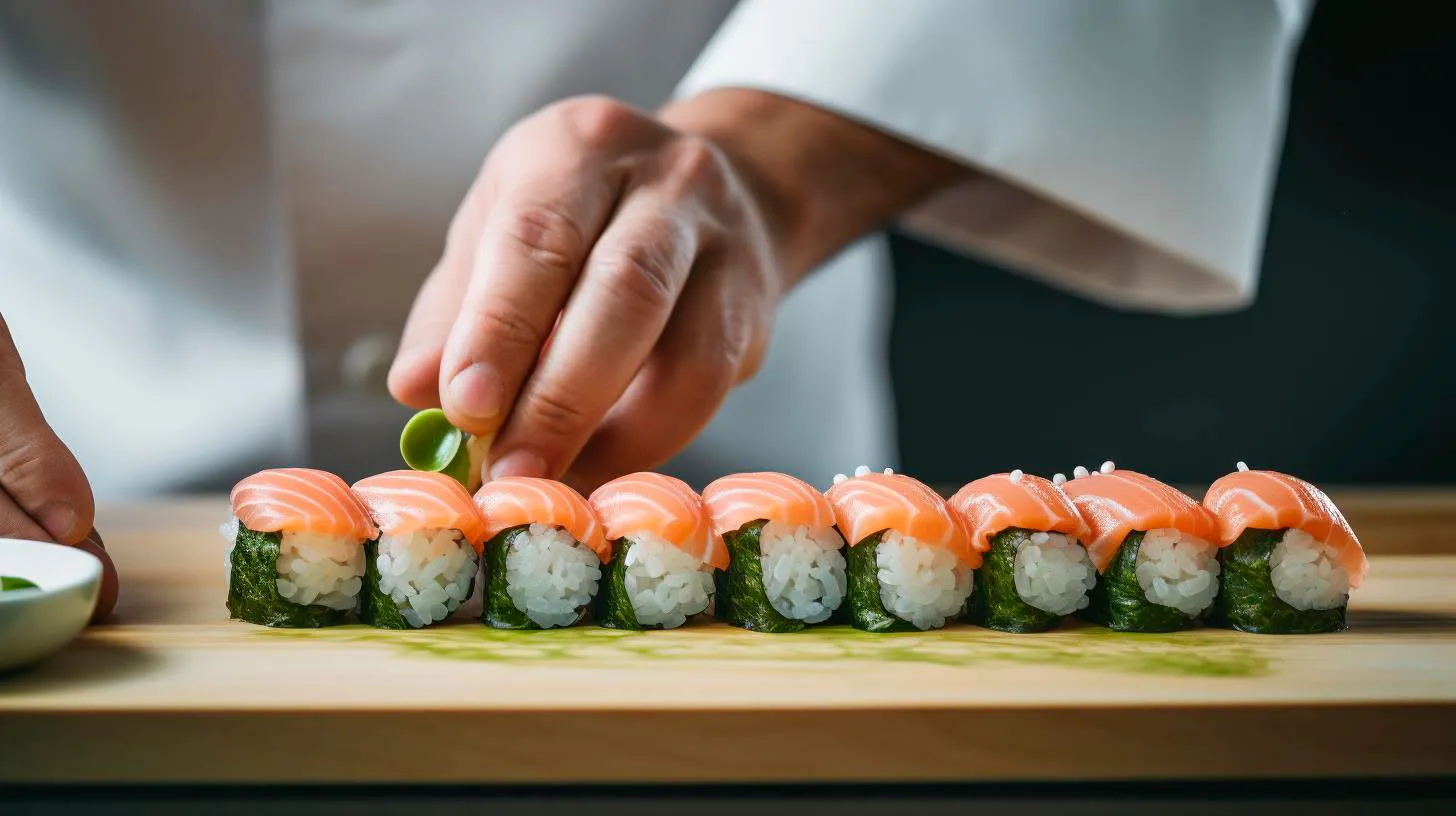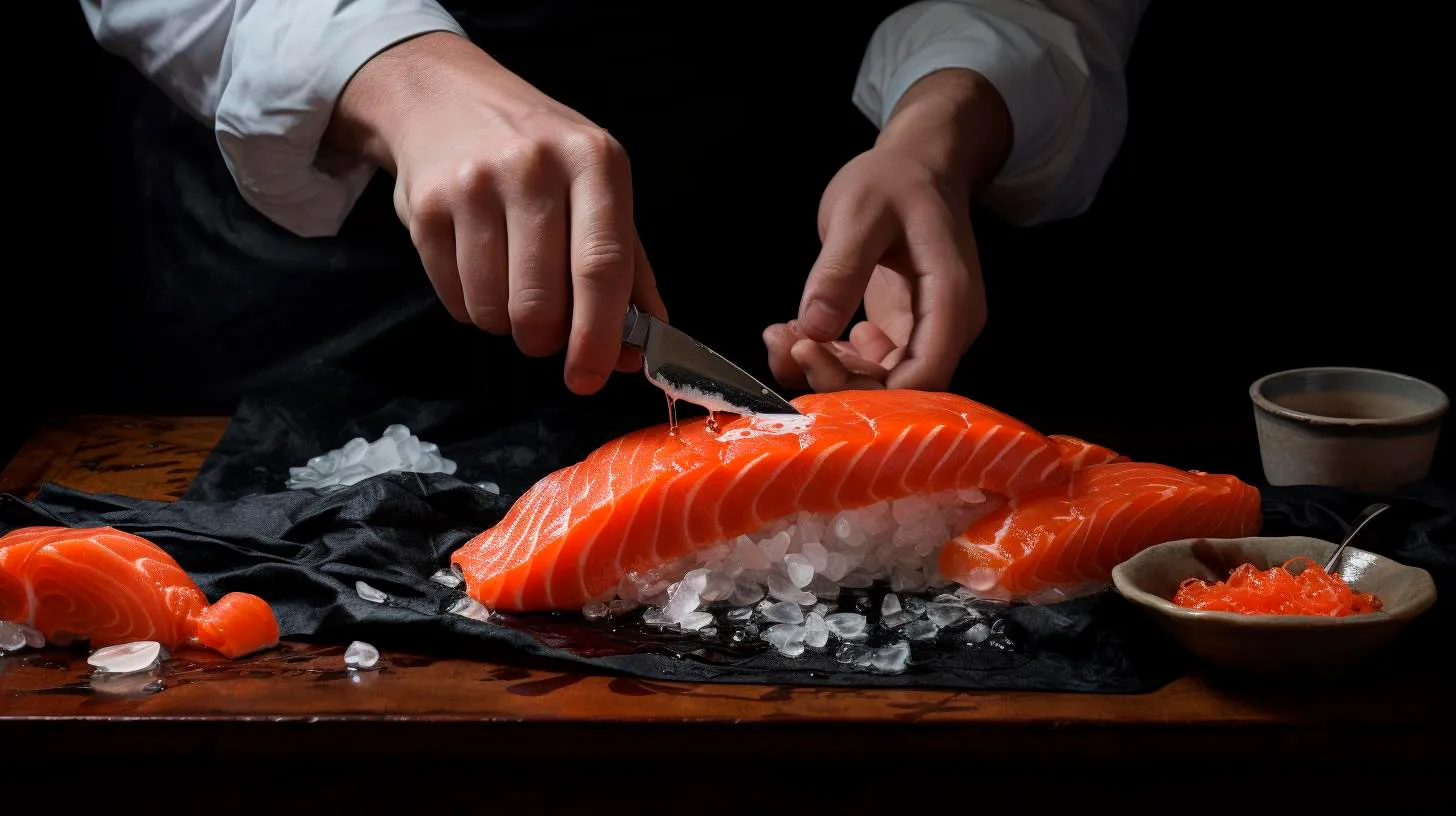From Blade to Plate: Unveiling the Craftsmanship of Sushi Chefs
The Art of Sushi Making
At the heart of sushi craftsmanship lies the art of rice preparation. Sushi rice, or shari, is the foundation that harmonizes all the other elements together. The chef combines steamed Japanese short-grain rice with a meticulously balanced vinegar mixture, which gives the rice its signature tangy flavor and sticky texture. The perfectly seasoned rice acts as a canvas, showcasing the quality and freshness of the fish or other ingredients used.
One key element that sets sushi chefs apart is their knife skills. Known for their precision and years of practice, sushi chefs skillfully wield their blades, transforming pieces of raw fish into delicate, bite-sized morsels. The sharpness and shape of their knives play a crucial role in achieving the desired texture and presentation of each sushi slice. Traditional Japanese knives, such as the yanagiba and deba, are commonly used due to their superb cutting abilities.
- Key takeaway: Sushi chefs’ mastery of knife skills helps in achieving precise and visually appealing slices of fish.
Another crucial aspect of sushi craftsmanship is selecting the freshest and highest-quality ingredients. Sushi chefs have a deep understanding of the flavor profiles, textures, and appearances of various types of fish, ensuring that only the finest specimens make it onto the plate. This expertise allows them to elevate the dining experience by curating the best possible combinations, creating a symphony of flavors that delight the senses.
Moreover, sushi chefs are well-versed in the art of presentation. Each sushi roll or piece is meticulously crafted, paying attention to aesthetics, color balance, and texture. Sushi is often garnished with carefully chosen toppings like fresh herbs, roe, or delicate edible flowers. These artistic flourishes not only enhance the visual appeal but also add layers of flavor and texture to the overall composition.
The Advantages of Traditional Sushi Techniques
In the fast-paced world of culinary innovation, the traditional methods employed by sushi chefs continue to play a vital role. Here are some advantages of sticking to the time-honored techniques:
- Preservation of authenticity: Traditional sushi techniques preserve the essence of this centuries-old Japanese culinary art, ensuring that its cultural significance is honored.
- Enhanced flavors: The meticulous attention to detail in every step of sushi preparation results in a well-balanced combination of flavors, showcasing the inherent taste of each ingredient.
- Artistic presentation: The emphasis on visual appeal in sushi creation turns every dish into a feast for the eyes, heightening the dining experience.
- Focus on quality: By prioritizing quality ingredients and time-tested methods, sushi chefs guarantee the highest standards of taste and freshness.
- Promotion of craftsmanship: Embracing traditional sushi techniques helps sustain the art of sushi making and supports the ongoing development of skilled sushi chefs.
Statistics Reflecting Sushi’s Popularity
The widespread popularity of sushi is a testament to its universal appeal. Consider these industry statistics:
- Sushi consumption in the United States has grown by over 50% in the past decade, with Americans spending an estimated $2.25 billion on sushi annually.
- Japan, the birthplace of sushi, boasts over 45,000 sushi restaurants.
- Over 80% of Japanese people visit a sushi restaurant at least once a month.
These figures demonstrate the global fascination with sushi and the enduring demand for skilled sushi chefs who can deliver an exceptional dining experience.
In Conclusion
Sushi making is an art form that requires precision, skill, and dedication. The craftsmanship of sushi chefs, from their knife techniques to ingredient selection and artistic presentation, is what makes sushi such an extraordinary culinary experience.
By showcasing their expertise, sushi chefs bring to life a harmonious blend of flavors, textures, and aesthetics that leave a lasting impression on diners. As sushi continues to captivate taste buds worldwide, we can only marvel at the timeless craftsmanship that transforms simple ingredients into masterpieces, from blade to plate.
The Art of Nigiri: Mastering Sushi Elegance
Each bite-sized piece is carefully crafted, representing the skill and expertise of the sushi chef. In this article, we explore the art of nigiri and uncover the secrets to mastering sushi elegance.
The Essence of Nigiri
Nigiri sushi comprises a slice of raw or cooked fish, typically resting atop a small mound of seasoned sushi rice. This minimalist approach allows the inherent flavors of the fish to shine and pairs it harmoniously with the subtle umami taste of vinegared rice. Every aspect of nigiri sushi, from the quality of ingredients to the precision of cutting techniques, plays a vital role in achieving the perfect balance and texture.
Meticulous Ingredient Selection
The journey to creating exemplary nigiri starts with selecting the finest ingredients. Sourcing fresh, high-quality fish is paramount for nigiri. The fish should be handled and frozen properly to ensure safety and maintain optimal flavor. Along with fish, other key ingredients like sea urchin, egg, and shellfish can offer diverse flavor profiles to enhance the nigiri experience.
Knife Skills: The Art of Cutting
The way a sushi chef handles the knife is a true reflection of their mastery. Precise knife skills are essential in crafting nigiri that not only looks visually appealing but also has the perfect texture. The chef carefully slices the fish against the grain to ensure tenderness, while maintaining the appropriate thickness for optimal taste. Each delicate cut showcases the chef’s expertise and attention to detail.
Sushi Rice: The Foundation
Not to be overshadowed by the fish, the sushi rice in nigiri plays a critical supporting role. Sushi rice is meticulously cooked and seasoned with a delicate balance of rice vinegar, sugar, and salt. The perfect texture and taste of the rice provide a neutral but flavorful base for the fish. The grains should stick together without being too sticky, allowing the sushi to be easily picked up and enjoyed.
Key Takeaways:
- Nigiri sushi is a minimalist and elegant form of sushi that showcases the flavors of the fish and complements it with vinegared rice.
- Selecting fresh and high-quality ingredients is crucial for creating exceptional nigiri.
- A sushi chef’s knife skills are a true reflection of their expertise and attention to detail.
- The sushi rice serves as the foundation, providing the perfect texture and complementing the fish.
The Perfect Bite
When enjoying nigiri, it is essential to savor each bite mindfully. The graceful combination of fish and rice is intended to be experienced as a whole. The flavors should meld together harmoniously, delivering a burst of umami with each mouthful. The sushi chef meticulously molds and shapes each piece, ensuring it is the perfect size for a single, satisfying bite.
Presentation: A Feast for the Eyes
In Japanese cuisine, presentation is highly valued, and nigiri is no exception. The visual aspect of nigiri adds to its overall appeal. The chef’s careful arrangement of colors, textures, and shapes creates an exquisite masterpiece. Whether served on a traditional wooden board or a modern ceramic plate, nigiri offers a feast for the eyes before it even reaches the palate.
Key Takeaways:
- Enjoy nigiri mindfully, savoring the combination of fish and rice.
- Nigiri’s appeal extends beyond taste through its exquisite presentation.
- The chef’s attention to visual details enhances the overall nigiri experience.
Embracing Tradition, Inspiring Innovation
While nigiri sushi holds deep roots in Japanese tradition, modern chefs have also found inspiration to push the boundaries of creativity. By respecting the traditional techniques and flavor pairings, chefs can experiment with new ingredients, textures, and flavors to create unique nigiri experiences.
Appreciating the Art of Nigiri
Mastering the art of nigiri requires time, dedication, and a deep appreciation for the craftsmanship involved. It is a delicate dance between elegance and taste, where precision and creativity intersect. Every piece of nigiri tells a story and offers a glimpse into the fascinating world of sushi culture.
So, the next time you indulge in nigiri sushi, take a moment to appreciate the skill and artistry behind each bite. Let the flavors transport you to the culinary wonders of Japan, where tradition and innovation meet to create a truly exceptional dining experience.
Sushi Etiquette: Embracing the Graceful Traditions of the Samurai
In this article, we will delve into the world of sushi etiquette, exploring the customs and practices embraced by the Samurai, and how they continue to shape the dining experience today.
The Importance of Sushi Etiquette
Understanding and appreciating sushi etiquette not only enhances your dining experience but also demonstrates respect for the rich cultural heritage from which it originates. By following these traditions, you can fully immerse yourself in the artistry and history associated with this iconic Japanese dish.
Situation 1: Navigating the Sushi Bar
When dining at a sushi bar, it is essential to acknowledge the hierarchical structure. Here are some key points to keep in mind:
- Wait for the sushi chef to acknowledge you before taking your seat.
- Upon entering the sushi bar, a customary greeting, such as “Irasshaimase” (welcome), is appropriate.
- Respect the chef’s authority and allow them to guide your dining experience.
- Engage in polite conversation if the chef shows interest, but avoid disturbing their focus.
Situation 2: Mastering Chopstick Etiquette
Using chopsticks correctly is crucial when enjoying sushi. Follow these guidelines:
- Do not use chopsticks to pass food directly from one pair of chopsticks to another, as this is reminiscent of a funeral ritual.
- Rest your chopsticks on the provided chopstick rest when taking breaks or waiting between sushi courses.
- Avoid spearing or impaling the sushi with your chopsticks, as it is considered disrespectful.
Situation 3: Navigating the Condiments
Properly handling the condiments provided with sushi is crucial to maintaining traditions:
- Use the soy sauce sparingly, dipping only a small portion of the sushi into it to avoid overpowering the flavors.
- When dipping sushi into soy sauce, flip it over so that the fish touches the sauce, not the rice.
- Wasabi, when included with the sushi, should be mixed into the soy sauce to create a balanced flavor.
Situation 4: Enjoying Raw vs. Cooked Sushi
The way you handle raw and cooked sushi differs, reflecting the importance of showcasing flavors in the best possible way:
- Raw sushi, often featuring delicate fish or seafood, should be consumed as soon as it is served to ensure the freshness and taste.
- Cooked sushi, such as eel or tamago (sweet omelet), can be enjoyed at a slower pace.
Key Takeaways
Embracing sushi etiquette allows you to connect with the long-standing traditions established by the Samurai, while also elevating your dining experience. Here are the key takeaways:
- Respect the hierarchical structure at the sushi bar and follow the guidance of the sushi chef.
- Master chopstick etiquette by avoiding disrespectful actions and using the chopstick rest.
- Handle condiments like soy sauce and wasabi in a way that complements the flavors of the sushi.
- Consume raw and cooked sushi differently, focusing on the freshness of raw pieces and savoring the variety of cooked options.
By embracing the customs and traditions associated with sushi etiquette, you not only pay homage to its historical origins but also gain a deeper appreciation for the artistry and harmony of Japanese cuisine. So next time you indulge in this exquisite delicacy, remember to embrace the graceful traditions of the Samurai and savor each bite with respect and admiration.
Beyond Wasabi: Unraveling the Secrets of Sushi Flavor Pairings
In this article, we will delve into the secrets of sushi flavor pairings, exploring the traditional combinations and offering insights on how to elevate your sushi experience to new heights.
The Art of Sushi Flavor Pairings
Sushi is not merely a meal; it is an experience that engages all your senses. The balance of flavors in sushi is of utmost importance, as it determines the overall taste and enjoyment. Traditional Japanese cuisine follows the concept of “Ichiju-Sansai,” where a single bowl of rice is accompanied by three carefully selected dishes to create a harmonious meal. Similarly, in sushi, the pairing of different ingredients is essential to achieve a well-balanced and delightful taste profile.
The Role of Umami
One cannot discuss sushi flavor pairings without mentioning the prominent role of umami. Umami,often referred to as the fifth taste, is a savory flavor that enhances the overall taste experience. It is present in various ingredients used in sushi, such as soy sauce, miso, and seaweed. The delicate balance of umami with other flavors such as sweet, sour, bitter, and salty is what makes sushi truly exceptional.
Traditional Sushi Flavor Combinations
Traditional sushi combines various ingredients in a way that balances flavors and textures. Here are some classic flavor combinations:
- Maguro (tuna) and scallions: The rich, fatty texture of maguro is complemented by the freshness of scallions, creating a delightful contrast.
- Unagi (grilled eel) and sweet soy glaze: The slightly sweet and smoky flavor of grilled eel pairs perfectly with the sweet soy glaze, resulting in a delectable combination.
- Hamachi (yellowtail) and jalapeno: The buttery taste of hamachi is elevated with a hint of spiciness from jalapeno, adding a refreshing twist to this classic pairing.
Elevating Your Sushi Flavor Game
While traditional flavor combinations hold their charm, there is always room to experiment and push the boundaries. Here are a few ways to elevate your sushi flavor game:
- Exploring fusion flavors: Embrace the fusion of flavors by incorporating ingredients from different cuisines. For example, try pairing salmon nigiri with a slice of mango to create a tropical twist.
- Enhancing textures: Along with flavors, textures play a crucial role in sushi. Experiment with crunchy elements like tempura flakes or tobiko (fish roe) to add a delightful crunch to your rolls.
- Playing with dipping sauces: Beyond the traditional soy sauce, experiment with different dipping sauces like spicy mayo, ponzu, or citrus-infused soy sauce to create a unique flavor explosion.
Your Sushi Flavor Journey
Embarking on a sushi flavor journey is an exciting endeavor. By understanding the art of sushi flavor pairings and experimenting with different combinations, you open up a world of taste possibilities. Whether you prefer traditional flavors or enjoy exploring innovative combinations, sushi offers an endless array of flavors to satisfy your culinary curiosity.
Unlock the secrets of sushi flavor pairings, and take your sushi experience beyond wasabi. Embrace the perfect balance of umami, experiment with traditional and fusion flavors, and elevate your sushi game to new heights. Let your taste buds embark on a culinary adventure that mesmerizes your senses and leaves you craving for more.


